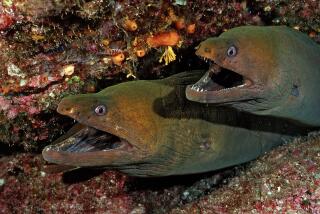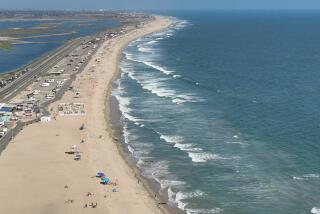Exploring the Gibraltar of the Pacific Coast
- Share via
Morro Rock could have served as inspiration for that 1960s Simon and Garfunkel tune with the “I am a rock, I am an island” refrain. Indeed, Morro Rock was an island located about 1,000 feet offshore until the late 1800s, when harbor makers started expanding Morro Bay’s entrance and sand shoals began piling up between the rock and the mainland.
As a result of such tidal tampering, Morro Rock became part of what geographers call a tombolo, a sand spit that connects an island to the mainland. (Point Sur Light Station, on the rugged Big Sur coastline, is perched on the Central Coast’s other famed tombolo.)
Morro is a slimmer and trimmer rock than the great rounded dome that explorer Juan Rodriguez Cabrillo named “El Morro” when he sailed by in 1542. Morro is missing a million tons or so of basaltic rock, the result of quarrying operations that took place from the 1880s until 1969, when the rock was finally declared a state park preserve. Most of the rock removed from Morro was used to construct breakwaters at Morro Bay and San Luis Bay.
Morro Strand State Beach offers the hiker an altogether different perspective on Morro Rock than the usual postcard view from Morro Bay. As viewed from the south, Morro Rock is part of a busy scene that includes the harbor, a shoreline power plant and the town of Morro Bay. From a viewpoint to the north, the “Gibraltar of the Pacific” appears much more solitary, more island-like. From this angle, it’s easy to imagine Morro’s past life as an undersea volcano.
Bring your binoculars on this coast walk. Morro Bay attracts flocks of migratory waterfowl in the winter, including ruddy ducks, wigeons, buffleheads and pintails. Scores of grebes, loons, terns and black brants (small geese that fly in from northern Canada) also winter here.
This hike begins at a particularly intriguing trail head called the Cloisters, a combination wetland, small housing development and city park that’s sandwiched between California 1 and the low dunes back of Morro Strand State Beach. Wildlife experts, landscape architects and park officials teamed up to create a pond and related natural habitats designed to attract a variety of birds. The developer of the Cloisters was required to make these unusual environmental efforts in order to build on adjacent property.
You can learn more about the Cloisters via an asphalt trail that encircles the wetlands and some interpretive signs. Other trails link the Cloisters to the beach.
Directions to trail head: From California 1 about two miles north of downtown Morro Bay, turn west on San Jacinto Street, then bear south through a small subdivision to the parking lot.
The hike: From the developed part of the park with the children’s playground, walk oceanward toward the low dunes and join a boardwalk path. (Detour briefly north if you wish to read the Cloisters’ interpretive signs.) This walk heads south alongside the dunes. The boardwalk curves through the dunes and dead-ends on the beach. Head south down the beach toward mighty Morro Rock.
Your trail is a broad, sandy beach formerly called Atascadero (“bog” in Spanish) State Beach. In 1991 state park officials renamed it Morro Strand State Beach. The beach is bisected into northern and southern sections by a campground located half a mile north of the Cloisters.
Some surf fishers, surfers and clam-diggers know about this beach, but not many. You might find yourself accompanied only by your thoughts as you meander Morro Strand.
Trail’s end is the base of Morro Rock. Coleman City Park, located just inland from the rock, has some picnic tables.
On your return, savor the views of the Santa Lucia Mountains, which seem to curve with the coast toward Big Sur.
(BEGIN TEXT OF INFOBOX / INFOGRAPHIC)
Morro Strand Trail
WHERE: Morro Strand State Beach.
DISTANCE: From the Cloisters to Morro Rock is 3.2 miles round trip.
HIGHLIGHTS: Unique look at Morro Rock from infrequently visited beach.
DEGREE OF DIFFICULTY: Easy.
FOR MORE INFORMATION: Morro Bay State Park; tel. (805) 772-7434.






